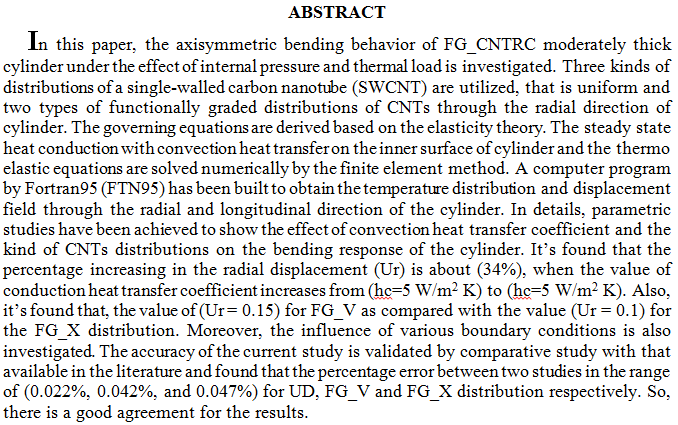
This study investigates the impact of varying glass fiber-reinforced polymer (GFRP) stirrup spacing on the performance of doubly GFRP-reinforced concrete beams. The research focuses on assessing the behavior of GFRP-reinforced concrete beams, including load-carrying capacity, cracking, and deformability. It explores the feasibility and effectiveness of GFRP bars as an alternative to traditional steel reinforcement in concrete structures. Six concrete beams with a cross-section of 300 mm (wide) × 250 mm (deep), simply supported on a 2100 mm span, were tested. The beams underwent four-point bending with two concentrated loads applied symmetrically at one-third of the span length, resulting in a shear span (a)-to-depth (h) ratio of 2.
... Show More (9)
(9)
 (8)
(8)
Quantum dots (QDs) can be defined as nanoparticles (NPs) in which the movement of charge carriers is restricted in all directions. CdTe QDs are one of the most important semiconducting crystals among other various types where it has a direct energy gap of about 1.53 eV. The aim of this study is to exaine the optical and structural properties of the 3MPA capped CdTe QDs. The preparation method was based on the work of Ncapayi et al. for preparing 3MPA CdTe QDs, and hen, the same way was treated as by Ahmed et al. via hydrothermal method by using an autoclave at the same temperature but at a different reaction time. The direct optical energy gap of CdTe QDs is between 2.29 eV and 2.50 eV. The FTIR results confirmed the covalent bonding betwee
... Show More (6)
(6)
Carbides or nitrides thin films present materials with good mechanical properties for industrial applications as they can be coatings at low temperatures serve temperature sensitive surfaces. In this work the effect of the C percentage on the mechanical properties represented by the Young modulus (E) of combinatorial magnetron sputtered TiCx (34%x˂65%) has been studied. The structure of the produced films is TiC independent on the C concentration. The mechanical properties are increased with increasing the C concentration up to 50%, and then decreasing with further C % increasing. These results can be explained by considering the resultant residual stresses.
The physical, the thermal and the mechanical properties of Nano-composites, that consisted of Polyprime EP epoxy that reinforced by multi-walled carbon nanotubes (MWCNTs), have been studied. Various loading ratios, 0.1, 0.5, and 1 wt. %of MWCNT shave been infused into epoxy by a magnetic stirrer and then the hardener mixed with the mthat supplied with the epoxy. All sample shave been cutting using CNC machine. Tensile test, three-point bending, hardness tests, lee's disk, differential scanning calorimetry, water absorption and dielectric and electrical conductivity test were utilized on unfilled, MWCNT-filled epoxy to identify the loading effect on the properties of materials. Scanning electron microscopy (SEM) was used to determine the
... Show MoreRheological instrument is one of the basic analytical measurements for diagnosing the properties of polymers fluids to be used in any industry. In this research polycarbonate was chosen because of its importance in many areas and possesses several distinct properties.
Two kinds of rheometers devices were used at different range of temperatures from 220 ˚C-300 ˚C to characterize the rheological technique of melted polycarbonate (Makrolon 2805) by a combination of different investigating techniques. We compared the results of the linear (oscillatory) method with the non-linear (steady-state) method; the former method provided the storage and the loss modulus of melted polycarbonate, and presented the Cox-Merz model as well. One of the
In this research want to make analysis for some indicators and it's classifications that related with the teaching process and the scientific level for graduate studies in the university by using analysis of variance for ranked data for repeated measurements instead of the ordinary analysis of variance . We reach many conclusions for the
important classifications for each indicator that has affected on the teaching process. &nb
... Show MoreThe 3D electro-Fenton technique is, due to its high efficiency, one of the technologies suggested to eliminate organic pollutants in wastewater. The type of particle electrode used in the 3D electro-Fenton process is one of the most crucial variables because of its effect on the formation of reactive species and the source of iron ions. The electrolytic cell in the current study consisted of graphite as an anode, carbon fiber (CF) modified with graphene as a cathode, and iron foam particles as a third electrode. A response surface methodology (RSM) approach was used to optimize the 3D electro-Fenton process. The RSM results revealed that the quadratic model has a high R2 of 99.05 %. At 4 g L-1 iron foam particles, time of 5 h, and
... Show More (1)
(1)
 (1)
(1)
 (21)
(21)
 (19)
(19)
